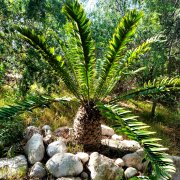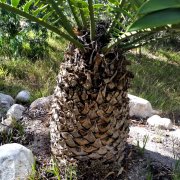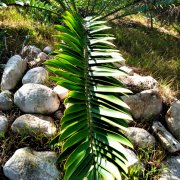Care of the cycad Encephalartos transvenosus or Modjadji cycad |
|
The genus Encephalartos, family Zamiaceae, includes 60 species of cycads native to Africa. Some species are: Encephalartos transvenosus, Encephalartos lehmannii, Encephalartos villosus, Encephalartos senticosus, Encephalartos natalensis, Encephalartos lebomboensis, Encephalartos horridus, Encephalartos ferox, Encephalartos altensteinii, Encephalartos aemulans, Encephalartos paucidentatus. Common names: Modjadji cycad, Modjadji's palm. This species is native to the Limpopo Province in South Africa. They are large, slow-growing, long-lived dioecious cycads that reach 12 meters (39.37 feet) in height. The long leaves up to 2.5 meters (8.2 feet) in length have bright green leaflets. They do not produce flowers but brown cones: the male cones reach 40 cm (15.74") in length and the large female cones weigh up to 40 kg (88 pounds). They bloom (produce cones) in late summer. Modjadji cycad is used as isolated specimens or in small groups protected from the wind. Young plants can be grown in pots. Encephalartos transvenosus prefers semi-shade exposure but will also grow in full sun if the summer is not too hot. It does not resist frost. The soil can be normal, well-drained garden soil with coarse sand and some organic matter. Planting is done in early spring. Water regularly in spring and summer so that the substrate does not dry out completely (never flood). In autumn and winter reduce watering. Fertilize in early spring with organic fertilizer. Modjadji cycad does not need pruning. Encephalartos transvenosus is a plant resistant to the usual pests and diseases. Modjadji's palm is propagated from seeds sown in spring or autumn and by separating the shoots produced by the plant at its base. |
Images of the cycad Encephalartos transvenosus or Modjadji cycad |
Find plants
Encephalartos transvenosus or Modjadji cycad | Care and Growing
© 2026 FavThemes


